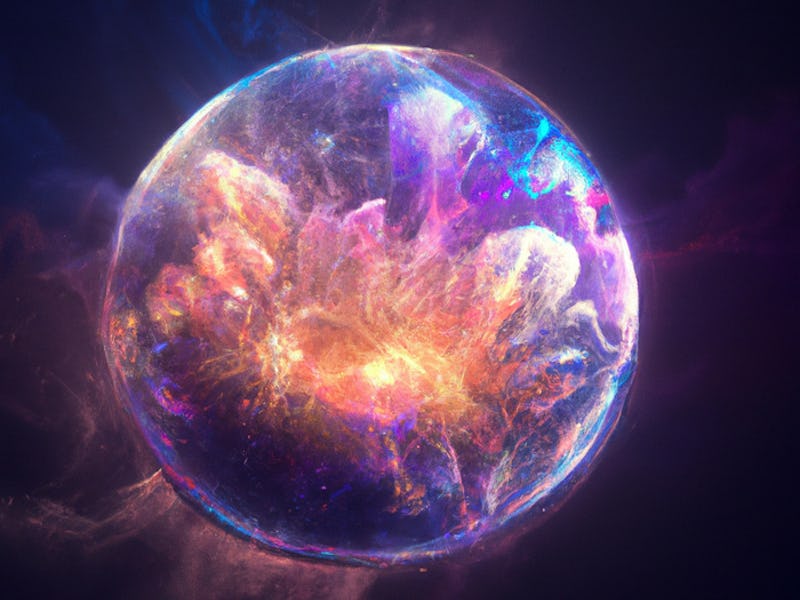This Historic Gravitational Wave Discovery Created a Perfectly Spherical Blast
The game-changing neutron star merger of August 2017 created a 'perfect' explosion, according to a new study.

A pair of space zombies show that dead stars are still capable of incredible physics.
When stars larger than the Sun meet their end, their hefty mass collapses, and this pushes subatomic particles past their quantum limits. It creates a neutron star, an object packed so densely that the mass of a star is stuffed into the diameter of a city. Sometimes, neutron stars come in pairs, orbiting one other just as they did as shining stars. They can then collide with extraordinary results. According to a new study published Wednesday in Nature, the cataclysmic explosion can take the shape of a perfect sphere.
Researchers found this out when they studied data from one of the most important astronomical events of the last century: the first direct detection of a merger of two neutron stars. Scientists observed the blast’s ripples in the fabric of space-time and its intense detonation of radiation.
“I find it quite amazing to think on the enormous collective effort of astrophysicists around the globe in taking this data. Both measuring the gravitational waves, finding the source of the explosion and detailing the distribution of light,” Albert Sneppen, a PhD student at the Niels Bohr Institute at the University of Copenhagen and lead author of the study, tells Inverse. “As such, I am standing on the shoulder of many great scientists — and it only due to the collective investment of all these people, that we can learn any deep truths about the Universe.”
This revolutionary scientific discovery carries two names, one for each leg of the story. The first was the ripples, or gravitational waves, that LIGO (short for Laser Interferometer Gravitational-wave Observatory) felt on August 17, 2017. This is designated GW170817. The second event appeared a few days later as a new bright flash to telescopes around the world, across the electromagnetic spectrum of light. These observations are known as AT2017gfo.
And for reasons not yet understood, this intense explosion of two neutron stars, called a kilonova, was close to a perfect spherical shape.
Perfectly spherical
“You have two super-compact stars that orbit each other 100 times a second before collapsing. Our intuition, and all previous models, say that the explosion cloud created by the collision must have a flattened and rather asymmetrical shape,” Sneppen shared in a statement that describes the new work.
Darach Watson, associate professor at the Niels Bohr Institute and study co-author, also shared their surprise about the perfect sphere shape for the blast. “No one expected the explosion to look like this,” Watson shared in the statement. “It makes no sense that it is spherical, like a ball. But our calculations clearly show that it is.”
“Undiscovered secrets of the Universe on the grandest scales are probably hiding in data already taken — but we have just not looked at it the right way,” Sneppen adds. “As such, I think the kilonova from 2017 has a few more secrets to tell concerning the formation of the heaviest elements, on the birth of the [subsequent] black hole, and perhaps even on the expansion rate of the Universe.”
It’s a challenge to explain what created the perfectly spherical blast.
One idea is there’s a “magnetic bomb,” Watson says. The neutron stars would combine for a few milliseconds to form one hypermassive neutron star. This short-lived amalgamation would blast out its magnetic field, and then collapse into a black hole. “The release of magnetic energy could cause the matter in the explosion to be distributed more spherically,” he adds.
Illustration of two crashing neutron stars.
There might be another explanation. “An alternative idea is that in the milliseconds that the hypermassive neutron star lives, it emits very powerfully, possibly including a huge number of neutrinos,” Sneppen says.
Neutrinos are subatomic particles with no electrical charge, roughly the size of an atom, with possibly zero mass that careen through space just shy of the speed of light.
“Neutrinos can cause neutrons to convert into protons and electrons, and thus create more lighter elements overall,” Sneppen says. It might explain discrepancies in their findings about the presence and location of kilonova byproducts, like gold.
“This idea also has shortcomings, but we believe that neutrinos play an even more important role than we thought,” he adds.
The team expects LIGO observatories to detect more kilonovas in the future.
If they are able to show another kilonova with this perfectly spherical symmetry, these blasts could be handy for measuring cosmic distances. “We need to both search for new objects and constantly re-examine the data we already have to push the boundary of our knowledge,” Sneppen says.